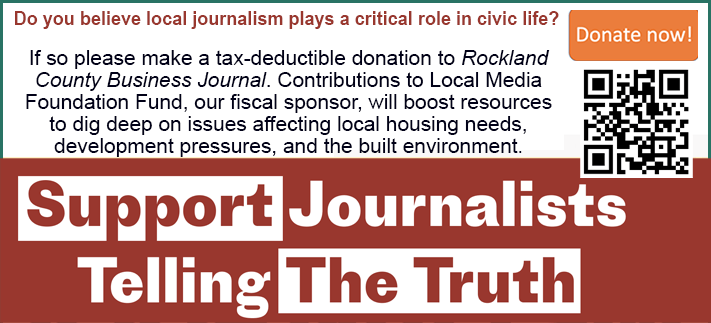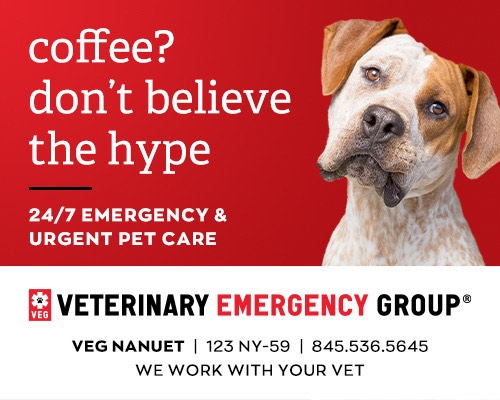|
RCBJ-Audible (Listen For Free)
|
Rockland Green’s Planned Animal Shelter On Beach Road In Village of West Haverstraw Will Become County’s Third Facility To Deal With Stray Animals
By Tina Traster
Until Rockland Green expanded its mandate to take charge of the county’s stray animals, the public authority that handles solid waste attracted little to no attention from taxpayers. The Authority’s annual tax levy in 2023 was $35 million, nearly 40 percent of its $82.4 million operating revenue, but residents don’t generally notice Rockland Green’s tax levy on their tax bill, nor do they weigh in on its spending decisions for two reasons. The first is that solid waste is just something we all want dealt with. Secondly, most taxpayers don’t perceive Rockland Green to be a body of elected officials who can be voted in or out of office, depending on how the entity makes decisions that impact taxpayers.
It’s an interesting disconnect.
Rockland Green’s 17-member board is entirely comprised of elected officials except Stephen Powers, the director of public policy and governmental relations, who represents County Executive Ed Day, an elected official. The rest of the board is comprised of the five town supervisors, village mayors from the Village of Haverstraw and Grandview-on-Hudson, and nine Rockland County legislators.
It bears pointing out that Rockland Green is run by elected officials as it begins to undertake the construction of a county-wide animal shelter, which will add a third shelter option to the county. The shelter will compete with Hi Tor Animal Care Center, which is planning its next phase, and the Hudson Valley Humane Society — neither of which levy taxpayers.
Further, taxpayers are paying increasing attention to Rockland Green because it will have the power to formulate animal management policy once it builds its facility at a reconfigured 15,000 square-foot warehouse the Authority is under contract to buy at 427 Beach Road in the Village of West Haverstraw.
But what taxpayers want to know now, before Rockland Green goes forward, is how they can be heard about the future shelter plans. They want to know where input and opinions should be directed. And they’re questioning what Rockland Green knows about running an animal shelter and who has jurisdiction and oversight over Rockland Green.
A good place to begin is to define a Public Authority and how it functions differently than town or county government. Public Authorities are like private corporations but are created by the state – generally through a legislature, not a governor – to advance public interests, notably infrastructure. Unlike state-funded agencies, which are accountable to the state, public authorities maintain a great deal of independence. They are typically governed by boards of directors appointed by elected officials to serve fixed terms.
The Rockland County Solid Waste Management Authority Enactment Act was adopted by the Rockland County Legislature on July 19, 1994. Oddly, rather than the Authority’s board being appointed by elected officials, its board is made up of elected officials. In essence, the board doesn’t answer to anyone other than the board, but these individual elected officials do answer to their constituents. When it came to changing its charter, it needed approval from the Rockland County Legislature (remember nine of the county legislators sit on Rockland Green’s board.)
But when it comes to spending decisions, Rockland Green does not face public scrutiny. Public Authorities basically have an open checkbook. There is no further input nor oversight on these taxpayer-impacted decisions from any other branch of Rockland’s government. There is no need for voter approval on anything that relates to the future shelter or the management of animals.
Rockland Green’s Operating Budget Doubles From 2014
Rockland Green’s 2023 annual operating budget of $82.4 million has nearly doubled from 2014, when its operating budget was $47 million – a 75 percent increase in less than a decade. The tax levy over the same period increased by 63 percent, a far greater spike than municipal or school budgets, largely due to tax caps which Rockland Green is not subject to.
The Authority’s operating budget increased 16 percent just from 2021 to 2022, rising from $63.5 million to $73.7 million –And from 2022 to 2023, the budget rose another $9 million, or another 12 percent.
Public Authorities typically own assets they build but rely on revenue bonds raised through taxpayer dollars to build those assets.
In 2022, the Authority was carrying $52 million in bond debt, which is paid from its operating revenues including tax levies. But this bond debt does not include future costs that will be generated by the acquisition and construction of the shelter. According to an audit conducted in 2022 by BST & Company of Latham, NY, “The Authority will fund shelter operations in the long-term through a tax levy to County residents beginning in 2023.”
This year, Rockland’s residents were levied about $20 per household but that tax is likely to skyrocket as the Authority moves forward with its plans to convert the warehouse into a shelter and then presumably maintains a full staff with benefits and pensions. Estimates for the warehouse construction project today exceed $15 million but are guaranteed to rise as interest rates remain high and the cost of construction rises.
When Rockland Green chose to buy 427 Beach Road in the Village of West Haverstraw, a warehouse built on spec by Stony Point developer Bruce Smith, for $3.8 million to house a future animal shelter, the Authority made that decision with the blessing of Rockland Green’s board – the 17 elected officials who signed off on a resolution to purchase property.
Additionally, the Authority signed a one-year lease for 2023 with the warehouse seller for an additional $225,000.
Rockland Green Chairman Howard Phillips said at a public meeting the decision to lease was based on the seller’s need to mitigate a capital gain tax in 2023. Rockland Green agreed to delay the closing until 2024.
Rockland Green Spends Nearly $1 Million in 2022 in Legal Fees On Animal Management
In April, Rockland Green’s auditor reported on the Authority’s financial statements from 2022. They were given a clean bill of health. But what stood out was a payment of nearly $1 million in legal fees for “providing animal management services” in 2022.
Rockland Green lists at least four attorneys on its payroll, including Lawrence Garvey, the Rockland County Chair of the Republican party and primary challenger to Clarkstown Supervisor George Hoehmann, who works 20 hours a week for Rockland Green for $79,500 annually. It also relies heavily on outside counsel.
The Public Authority is top heavy with salaries/pensions, and more than half of its workforce, according to a chart on its website, are professionals, accountants, engineers, attorneys as well as an Intergovernmental Relations Coordinator, and a Confidential Assistant to Executive Director Gerard Damiani, Jr.
According to the website OpenPayrolls.com, which tracks public salaries, in 2021 Rockland County Solid Waste Management Authority reported eight employees making more than $100,000 per year; by comparison the average salary was $80,261.
According to SeeThroughNY.com, in 2022, the highest reported pay was $176,142 for Gerard Damiani, Executive Director, $165,921 for Jeremy Goldstein, Director of Finance, and $124,385 for Ryan Montal, confidential assistant to the Executive Director.
In August 2022, the New York State Legislature approved an act to expand the Rockland County Solid Waste Authority’s purposes, powers, and responsibilities to include providing animal management services through a wholly owned subsidiary. What’s notable is that the Act amended the agriculture and markets law, in relation to any public authority to provide shelter services for the care of unwanted animals.
“This is an outlier,” said a state official familiar with public authorities. “This is not an extensive practice for a public authority. This appears to be a first toe in the water.”
Public authorities are typically responsible for a wide range of public functions including transportation, energy, environmental protection, housing, and economic development. Institutions built on the public authority model exist at all levels of government. The Port Authority of New York and New Jersey, the MTA and the New York Dormitory Authority are among the most well known in the state. Despite their ubiquity, public authorities remain a mystery, especially to taxpayers. Many release little information about their internal operations.
Rockland Green holds a monthly public meeting at 5 pm on either a Tuesday or Thursday – a time many residents say is inconvenient to attend, if they even know about the meeting at all. The one-hour meeting leaves little time for public questions, which have ratcheted up since the Public Authority commandeered animal management and have brought residents to the meetings.
Bearing witness to nearly two years of these monthly public meetings, it’s fair to say county residents with questions and concerns over the location of the new shelter, which is adjacent to the Joint Sewer Authority (another public authority headed up by Howard Phillips, who also chairs Rockland Green) do not feel as though their issues have been adequately addressed. Questions about the property’s proximity to a planned 450,000 square-foot, 24/7 truck depot, odors from the Joint Regional Authority, and the location being in a flood zone have been treated with dismissal.
Again, residents should bear in mind that Rockland Green is made up of elected officials entirely. If they don’t have access to a Town Supervisor or Legislator at a Rockland Green board meeting, they do have that access at town board meetings and other channels. Public Authorities are not subjected to the oversight and transparency requirements that apply to other government agencies, nor are they held accountable for their contracting practices and day-to-day operations, but elected Supervisors and Mayors are.
Hi Tor Planning Its Future; Rockland Green Will Add Third Animal Shelter To County
Public authorities are set up to allow officials to borrow money to provide capital for construction and public infrastructure projects. Issuing debt allows the entities to spread the cost of a capital asset over its useful life, for example, making it an effective financing tool for a highway, airport expansion, public housing, hospital, schools, power plants.
“New York’s public authorities play an increasingly influential role in government, yet they operate outside the traditional checks and balances that apply to state agencies,” said DiNapoli. “Some of these entities are repeatedly used in a way that circumvents borrowing limits and oversight.”
Public Authorities typically generate their own operating income by charging users for goods and services and then borrow for capital expenses based on projections of future revenues. Rockland Green has yet to present revenue and expense projections for the shelter.
Authorities typically levy fees or tolls to the users of that service and collect revenues. They are a well-established piece of the fabric of the way services are delivered in New York.
One source noted that public authorities are not necessarily problematic but he added, “unless there’s a well-serviced dedicated entity that has the ability to be more effective than a public authority.”
Ultimately, that is the question.
Does it make more financial and operational sense to have a private nonprofit run an animal shelter or a public authority? That question must be looked at in terms of taxpayers’ dollars, animal management policies, and knowledge and experience in the sheltering world. Prior to Rockland Green taking over animal management, the Towns between 2018 and 2022 paid less than $330,000 to help support the budget of Hi Tor, the county’s only full-service animal shelter. Hi Tor typically raised the balance of its nearly $1 million budget through grants and donations. The shelter, established nearly 60 years ago, has always relied on volunteers and an extensive network of fosters. The nonprofit has never been run as a for-profit entity, nor has its 20 or so employees enjoyed higher wages, benefits, or pensions.
For county residents to support Rockland Green’s animal management functions, they will not only bear the weight of bonds to build and maintain a building – they will likely be on the hook for employees, benefits, and pensions forever.
“The Authority appears to be monolithic, but the board is made up of separate elected officials,” said a public official who did not want to be identified. “The members of Rockland Green answer to Phillips, but they also answer to the public. I don’t believe every member is entirely comfortable with this shelter plan.”














